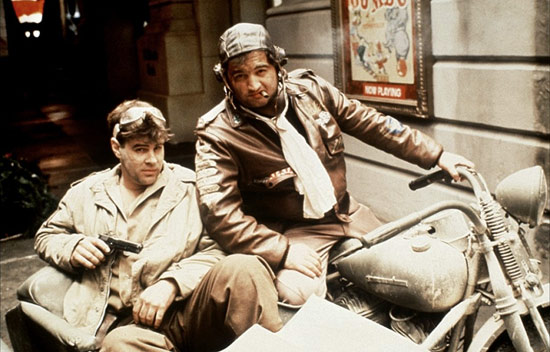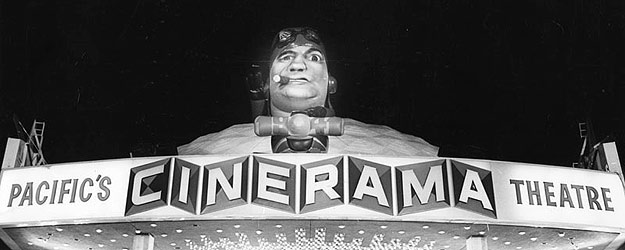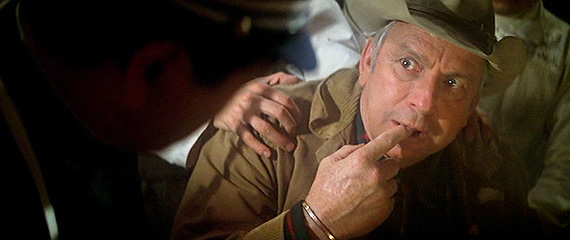“[Spielberg] has said he felt invincible at the time, so what you get is a Steven Spielberg channeling his inner ten-year-old and going crazy on a movie backlot.” — Mike Matessino
“The main reason to celebrate 1941,” says Mike Matessino, “is because it has been restored in HD and released on Blu-ray, particularly the extended version that fans have come to love and which Steven Spielberg considers his Director’s Cut.” Matessino produced the two-disc CD soundtrack release of 1941 issued by La-La Land Records in 2011 and will be hosting the American Cinematheque’s March 22nd screening of the film and cast-and-crew Q&A. The screening will mark the theatrical debut of a new DCP of the extended cut of the film. [Read more here...]
1941 is also celebrating its 35th anniversary, having been released in late 1979 and playing through the early months of 1980. And, nearly ten years after the format’s launch, 1941 finally received a release on Blu-ray Disc when it was among the titles chosen for inclusion in the recently released Steven Spielberg Director’s Collection Blu-ray set. (The set also includes Duel, The Sugarland Express, Jaws, E.T. The Extra-Terrestrial, Always, Jurassic Park, and The Lost World: Jurassic Park.) A stand-alone Blu-ray of 1941 is scheduled for release in May.

The Universal/Columbia co-production starred the ensemble of Dan Aykroyd, Ned Beatty, John Belushi, Lorraine Gary, Murray Hamilton, Christopher Lee, Tim Matheson, Toshiro Mifune, Warren Oates, Robert Stack, and Treat Williams. With a script by Robert Zemeckis & Bob Gale and John Milius, the epic comedy chronicles the paranoia and zaniness that ensues following the spotting of a Japanese submarine off the West Coast soon after the attack on Pearl Harbor. The film also features Nancy Allen, Eddie Deezen, Bobby Di Cicco, Dianne Kay, Slim Pickens, Wendie Jo Sperber, John Candy, and Lionel Stander.
1941 premiered at the Cinerama Dome in Los Angeles on December 13th, 1979. The film opened the following day in a few hundred theaters in the United States and Canada, including a handful of prestigious 70-millimeter presentations in high-profile markets such as New York (at the Rivoli), Los Angeles (Cinerama Dome), San Francisco (Northpoint), San Jose (Century 21), and Seattle (Crest). Opening weekend saw a third-place-finishing $2.7 million-gross (behind Star Trek: The Motion Picture and The Jerk) and plenty of negative reviews. The promotional tagline used was, “As they roared into battle, only one thing was missing… the enemy.” Some have thought, “As they roared into battle, only one thing was missing… the audience” may have been more accurate.

Co-screenwriter Bob Gale insists 1941 was not a flop. “Although it was pretty soundly trashed by the critics, it did make a modest profit,” says Gale, who also with Zemeckis wrote I Wanna Hold Your Hand, Used Cars and the Oscar-nominated Back to the Future. “I think a lot of the bad reviews had to do with the expectations of what Steven would do after Jaws and Close Encounters. And perhaps there were some critics who thought Steven was on too high a pedestal and he needed to be taken down a bit.” Spielberg’s film, his fourth theatrical production, grossed about $30 million domestic and more than $50 million internationally. So, even with its reported $35 million production cost and only about half of the theatrical take coming back to the distributor, any claims of flop status should be called into question.
 Gale, who will participate in the Q&A following the upcoming screening, says 1941 was the first feature script he and screenwriting partner Robert Zemeckis were hired to write after graduating from the University of Southern California’s School of Cinema-Television. John Milius, who received a co-writing credit on the film, was originally considered to direct. Milius had written Apocalypse Now for Francis Ford Coppola and had directed The Wind and the Lion (1975) and Big Wednesday (1978) and would go on to direct Conan the Barbarian (1982) and Red Dawn (1984). “We weren’t really thinking about who would direct it when we wrote it — we just wanted to write a crazy comedy,” says Gale. “John let Steven read it, and Steven said, ‘I want to direct this!’ and John figured that Steven was in a position to really put everything on the screen. Bob and I were just thrilled that the movie was getting made!”
Gale, who will participate in the Q&A following the upcoming screening, says 1941 was the first feature script he and screenwriting partner Robert Zemeckis were hired to write after graduating from the University of Southern California’s School of Cinema-Television. John Milius, who received a co-writing credit on the film, was originally considered to direct. Milius had written Apocalypse Now for Francis Ford Coppola and had directed The Wind and the Lion (1975) and Big Wednesday (1978) and would go on to direct Conan the Barbarian (1982) and Red Dawn (1984). “We weren’t really thinking about who would direct it when we wrote it — we just wanted to write a crazy comedy,” says Gale. “John let Steven read it, and Steven said, ‘I want to direct this!’ and John figured that Steven was in a position to really put everything on the screen. Bob and I were just thrilled that the movie was getting made!”
Was Spielberg a good choice to direct considering he had not made a comedy at that point in his career? “Of course, Steven was a great choice,” insists Gale. “Not many directors could convince a studio that it was a good idea to have an aerial dogfight on Hollywood Boulevard, a choreographed jitterbug number that turns into a huge riot, and a Ferris wheel rolling down Santa Monica pier, all in one movie.”
Gale says he has wonderful memories of the filming of the movie, and, unlike many screenwriters, he and Zemeckis were allowed to hang out on set during the production. “The cast was just incredible,” remembers Gale. “To have our dialog performed by actors we grew up watching — Toshiro Mifune, Slim Pickens, Robert Stack, Warren Oates, Christopher Lee — it was like being a kid in a candy store. Bob and I were 27 years old, and we concocted this ballet of insanity that involved hundreds, maybe a thousand people! We used to say, ‘it’s a 35 million dollar movie that was typed on a 30 dollar typewriter.’ And that was when a 35 million dollar budget made it one of the most expensive movies ever made. Today, to put those images on the screen, it’s probably north of $150 million, maybe more.”






